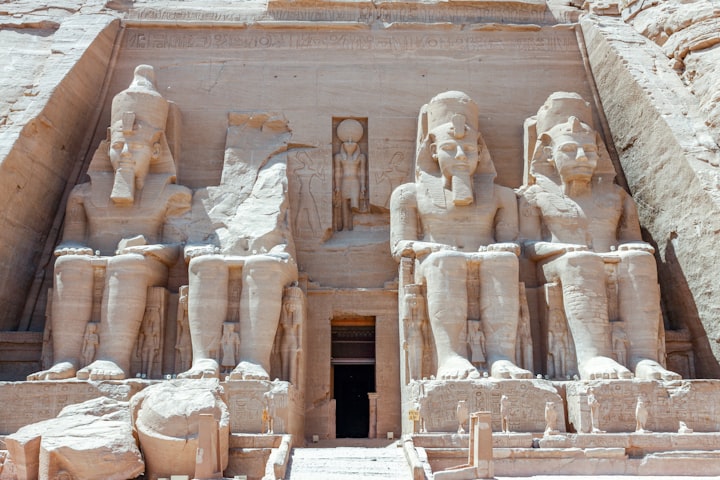10 Most Impressive Monuments of Ancient Egypt
Ancient Egypt

One of the world’s greatest civilizations, the Ancient Egyptians ruled over the lower reaches of the Nile for millennia. After a unified kingdom arose around 3100 BC, a series of dynasties and pharaohs built ever-bigger pyramids and temples before falling to the Roman Empire in 30 BC. Many of the massive monuments were dedicated to various deities or the pharaohs themselves and were adorned with rich decorations. Such was the ingenuity and engineering prowess of the Ancient Egyptians, that many of these amazing ancient monuments are still standing today.
Number 10. Temple of Hatshepsut.
Not far from the famed Valley of the Kings lies another of Egypt's incredible ancient sights; the Mortuary Temple of Hatshepsut. Located at the foot of towering cliffs that rise dramatically above the desert floor is a massive, almost modern-looking monument. Built for the female Pharaoh Hatshepsut who died in 1458 BC, the temple boasts three layers of terraces, all of which are lined by colossal colonnades. Once surrounded by lush gardens, they are connected by long ramps with well-preserved and colorful reliefs of animals, plants, and people alongside huge statues of Osiris.
Number 9. Dahshur Pyramids.
Set 25 miles or so to the south of Cairo is the royal necropolis that makes up the Dahshur Pyramids. Although they receive considerably fewer visitors due to their secluded setting in the Sahara, the pyramids are just as impressive as those of Giza. While there are several other smaller pyramids and ruins nearby, the standout sights are undoubtedly the Red Pyramid which dates to 2590 BC, and the misshapen Bent Pyramid. This is because the former is thought to be the first smooth-sided pyramid successfully built, while the latter is a unique example of an even earlier but unsuccessful attempt.
Number 8. Step Pyramid of Djoser
. Not far to the north of the Dahshur Pyramids is the Step Pyramid of Djoser which was remarkably the first monumental stone structure to be built by the Ancient Egyptians. Erected in the 27th century BC for the Pharaoh Djoser, it lies at the heart of the sprawling Saqqara necropolis with chapels and courts all around it. Due to its huge size and the ingenuity of the engineering required to erect it, the step pyramid represents an astonishing architectural achievement. Besides standing at 205 feet in height and having six steps, it also contains burial chambers, galleries, and tunnels within its crumbling walls.
Number 7. Edfu Temple.
One of the best-preserved examples of Ancient Egypt's engineering prowess is the extraordinary Edfu Temple, which lies midway between Luxor and Aswan. Constructed in the Ptolemaic Kingdom, between 237 and 57 BC, it boasts a breathtaking main entrance, as well as intricately carved reliefs and hieroglyphics. As it is dedicated to Horus, numerous images and statues of the falcon-headed deity can be found scattered around both its sanctuary and surrounding chapels. Some spectacular scenes can also be spied on its walls.
Number 6. Luxor Temple
. Known as the 'southern sanctuary' to the Ancient Egyptians, the large Luxor Temple complex lies on the banks of the Nile River in what was once the ancient city of Thebes. Built around the year 1400 BC during the New Kingdom, it has an exquisite architecture with superb shrines, sphinxes, and statues wherever you look. Unlike many of the temples in Egypt, Luxor Temple is not dedicated to a deity or pharaoh but to the rejuvenation of kingship. Consequently, it is thought that many pharaohs were crowned here amidst its courts and colonnades that lend the site such gravitas and grandeur.
Number 5. Great Sphinx.
Located at the Giza Plateau, The Great Sphinx is one of the largest and oldest monuments in the world, but basic facts about it, such as who was the model for the face, when it was built, and by whom, are still debated. It is the largest monolith statue in the world although it is considerably smaller than the Pyramids around it. Despite conflicting evidence and viewpoints over the years, the traditional view held by modern Egyptologists at large remains that the Great Sphinx was built in approximately 2500 BC by the pharaoh Khafre, the supposed builder of the second pyramid at Giza.
Number 4. Valley of the Kings.
The Valley of the Kings is a valley near Luxor where, for a period of nearly 500 years, tombs were constructed for the pharaohs of the New Kingdom. The valley contains 63 tombs and chambers, ranging in size from a simple pit to a complex tomb with over 120 chambers. The royal tombs are decorated with scenes from Egyptian mythology and give clues to the beliefs and funerary rituals of the period. All of the tombs seem to have been opened and robbed in antiquity. Only the famous tomb of Tutankhamun was spared from the worst of the tomb depredations.
Number 3. Abu Simbel.
Counted amongst the most majestic monuments in Egypt, Abu Simbel consists of two massive rock temples on the western bank of Lake Nasser. The twin temples were originally carved out of the mountainside during the reign of Pharaoh Ramesses The Great in the 13th century BC, as a lasting monument to himself and his queen Nefertari. The complex was relocated in its entirety in the 1960s to avoid their being submerged during the creation of Lake Nasser, the massive artificial water reservoir formed after the building of the Aswan Dam on the Nile River.
Number 2. Karnak
. The Karnak Temple complex in Luxor, Egypt, is impressive due to its sheer size. Covering an area that’s larger than most ancient cities, it’s dotted with temples, obelisks, and shrines. It took over 2,000 years to build and each Egyptian pharaoh left her own architectural mark. Walk through the Avenue of Sphinxes and discover the Great Hypostyle Hall. This enormous room filled with towering pylons and solid sandstone columns is one of the most famous and photographed attractions of Ancient Egypt. While you’re here, stop to admire the Sacred Lake and the nearby granite scarab.
Number 1. Pyramids of Giza.
Arguably the world’s most famous landmark, the Pyramids of Giza lie on the outskirts of Cairo, looking out over the endless sands of the Sahara. The pyramids in Giza were built over the span of three generations during the Fourth Dynasty of the Old Kingdom. The Great Pyramid of Khufu is the oldest and sole remnant of the Seven Wonders of the Ancient World. The pyramid is an awe-inspiring 455 feet high making it the largest pyramid in Egypt, although nearby Khafre’s Pyramid appears to be larger as it is building at a higher elevation.
About the Creator
Siddhartha Sapkota
I am a passionate content creator.






Comments
There are no comments for this story
Be the first to respond and start the conversation.